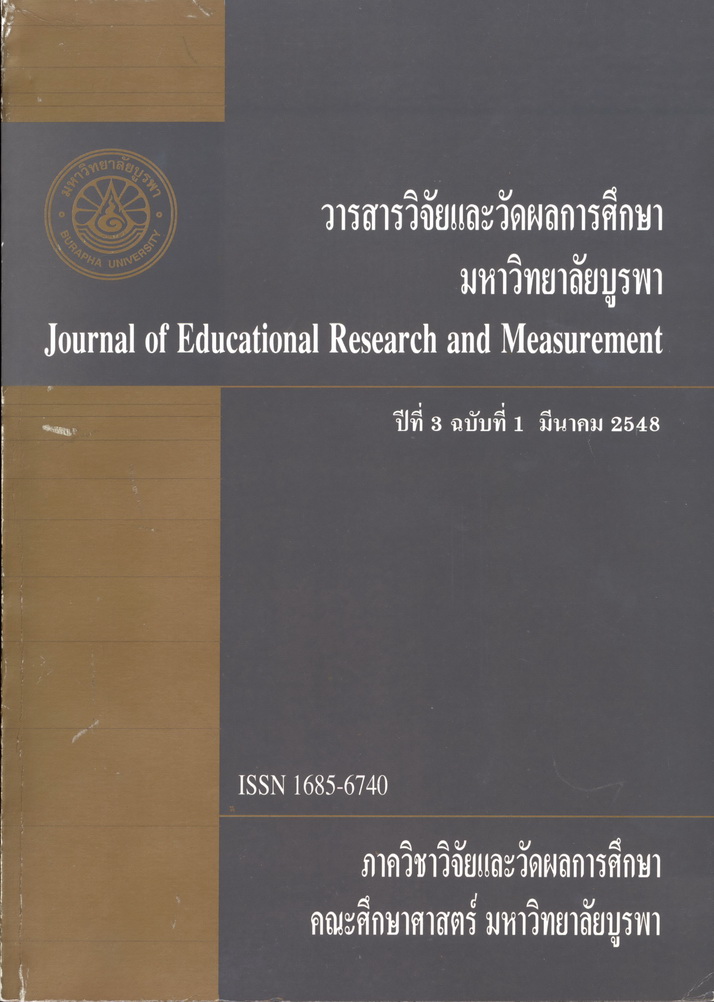การพัฒนาโมเดลความสัมพันธเชิงสาเหตุของความสามารถในการแกปญหา ทางคณิตศาสตรของนักเรียนชั้นมัธยมศึกษาปที่ 3
Main Article Content
Abstract
การวิจัยครั้งนี้มีวัตถุประสงคเพื่อพัฒนาและตรวจสอบความตรงเชิงโครงสรางของโมเดล ความสัมพันธเชิงสาเหตุของความสามารถในการแกปญหาทางคณิตศาสตรของนักเรียนชั้นมัธยมศึกษาปที่ 3 กลุมตัวอยางเปนนักเรียนชั้นมัธยมศึกษาปที่ 3 ในโรงเรียนสังกัดสํานักงานคณะกรรมการการศึกษาขั้น พื้นฐาน ภาคตะวันออก ปการศึกษา 2546 จํานวน 420 คน ตัวแปรที่ศึกษาประกอบดวยตัวแปรแฝง 6 ตัว ไดแก ความสามารถในการแกปญหาทางคณิตศาสตร แรงจูงใจใฝสัมฤทธิ์ทางการเรียนคณิตศาสตร แบบการคิด ความวิตกกังวลในวิชาคณิตศาสตร เจตคติตอวิชาคณิตศาสตร และความรูพื้นฐานเดิมทางคณิตศาสตร เครื่องมือ ที่ใชในการวิจัยประกอบดวย แบบวัดความสามารถในการแกปญหาทางคณิตศาสตร แบบวัด แรงจูงใจใฝสัมฤทธิ์ทางการเรียนคณิตศาสตร แบบวัดแบบการคิด แบบวัดความวิตกกังวลในวิชา คณิตศาสตร แบบวัดเจตคติตอวิชาคณิตศาสตร และแบบเก็บขอมูลเกรดวิชาคณิตศาสตร การวิเคราะห ขอมูลใชโปรแกรม SPSS ในการหาคาสถิติพื้นฐาน และใชโปรแกรม LISREL 8.50 ในการตรวจสอบความ ตรงเชิงโครงสรางของโมเดลความสัมพันธเชิงสาเหตุ ผลการวิจัยแสดงวา โมเดลความสัมพันธเชิงสาเหตุของความสามารถในการแกปญหาทางคณิตศาสตรมี ความสอดคลองกับขอมูลเชิงประจักษ โดยพิจารณาจาก คาไค-สแควร เทากับ 22.47 ที่องศาอิสระเทากับ 67 คา ความนาจะเปน เทากับ 1.00 ดัชนี GFI เทากับ 0.99 ดัชนี AGFI เทากับ 0.98 ดัชนี CFI เทากับ 1.00 คา SRMR เทากับ 0.01 และคา RMSEA เทากับ 0.00 ตัวแปรทั้งหมดในโมเดลสามารถอธิบายความแปรปรวนของ ความสามารถในการแกปญหาทางคณิตศาสตรไดรอยละ 63 ตัวแปรที่มีอิทธิพลทางตรงตอความสามารถในการ แกปญหาทางคณิตศาสตรอยางมีนัยสําคัญทางสถิติ ไดแก แรงจูงใจใฝสัมฤทธิ์ทางการเรียนคณิตศาสตร แบบการ คิด ความวิตกกังวลในวิชาคณิตศาสตร เจตคติตอวิชาคณิตศาสตร และความรูพื้นฐานเดิมทางคณิตศาสตร
DEVELOPMENT OF A CAUSAL RELATIONSHIP MODEL OF MATHEMATICAL PROBLEM SOLVING ABILITY OF GRADE NINE STUDENTS
The purpose of this research was to develop and validate a causal relationship model of mathematical problem solving ability of grade nine students. The sample involved 420 grade nine students in schools under the jurisdiction of the Commission for Basic Education in the eastern region, Thailand, academic year 2003. The model involved six latent variables: mathematical problem solving ability, mathematical achievement motivation, cognitive style, anxiety in mathematics, attitude toward mathematics, and prior knowledge in mathematics. Research instruments included the Mathematical Problem Solving Ability Test, the Mathematical Achievement Motivation Scale, the Cognitive Style Test, the Mathematic Anxiety Scale, the Attitude Toward Mathematic Scale, and the Mathematic Grade Questionnaire. SPSS was used to derive descriptive statistics; LISREL 8.50 was used to validate the causal relationship model. Results indicated that the model was consistent with empirical data. Goodness of fit indicators included a chi-square value of 22.47 with 67 degrees of freedom; p = 1.00; GFI = 0.99; AGFI = 0.98; CFI = 1.00; SRMR = 0.01; and RMSEA = 0.00. The variables in the model accounted for 63 percent of the variance of mathematical problem solving ability. The variables that had statistically significant direct effects on mathematical problem solving ability were mathematical achievement motivation, cognitive style, anxiety in mathematics, attitude toward mathematics, and prior knowledge in mathematics.
